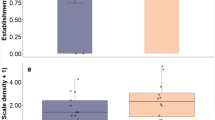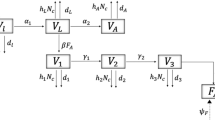Summary
Experiments are described that were designed to investigate the effects of food availability and rate of exploitation on the growth and production of populations of Folsomia candida (Willem). In an initial experiment in which there was excess food it was found that increasing the rate of exploitation resulted in increases in both the numerical and biomass productivity of the populations. In a second experiment it was shown that, when there is severe competition for food, the rate of exploitation does not affect either the biomass or the numerical production. It is concluded that the effect of overcrowding, in the form of competition for space, does contribute to the growth in numbers of populations, but that the supply of food plays a more important role in regulating the population. Anomalous results, showing that exploitation has a lesser effect when there is severe competition for food, are discussed.
Similar content being viewed by others
References
Goto H. E.: Facultative parthenogenesis in Collembola (Insecta). Nature (Lond.) 188, 958–959 (1960).
Green, C. D.: The effect of crowding upon the fecundity of Folsomia candida var. distincta. Ent. Exp. & Appl. 7, 62–70 (1964).
Marshall, V. G., Kevan, D. K. McE.: Preliminary observations on the biology of Folsomia candida Willem, 1902 (Collembola: Isotomidae). Canad. Ent. 94, 575–588 (1982).
Milne, S.: Studies on the life history of various species of Arthropleone Collembola. Proc. roy. entomol. Soc. (Lond.) (A.) 35, 133–140 (1960).
Nicholson, A. J.: Compensatory reactions of population to stresses and their evolutionary significance. Aust. J. Zool. 2, 1–8 (1954).
Silliman, R. P., Gutsell, J. S.: Experimental exploitation of fish populations. U. S. Fish Wildlife Service Fishery Bull. 58, 215–252 (1958).
Slobodkin, L. B., Richman, S.: The effect of removal of fixed percentages of the newborn on size and variability in populations of Daphnia pulicaria (Forbes). Limnology Oceanog. 1, 209–237 (1956).
Usher, M. B.: Seasonal and vertical distribution of a population of soil arthropods: Collembola. Pedobiologia 10, 224–236 (1970).
Watt, K. E. F.: Studies on population productivity. I. Three approaches to the optimum yield problem in populations of Tribolium confusum. Ecol. Monogr. 25, 269–290 (1955).
Williamson, M. H.: The analysis of biological populations. London: Edward Arnold (in press).
Author information
Authors and Affiliations
Rights and permissions
About this article
Cite this article
Usher, M.B., Longstaff, B.C. & Southall, D.R. Studies on populations of Folsomia candida (Insecta: Collembola). Oecologia 7, 68–79 (1971). https://doi.org/10.1007/BF00346294
Received:
Issue Date:
DOI: https://doi.org/10.1007/BF00346294




